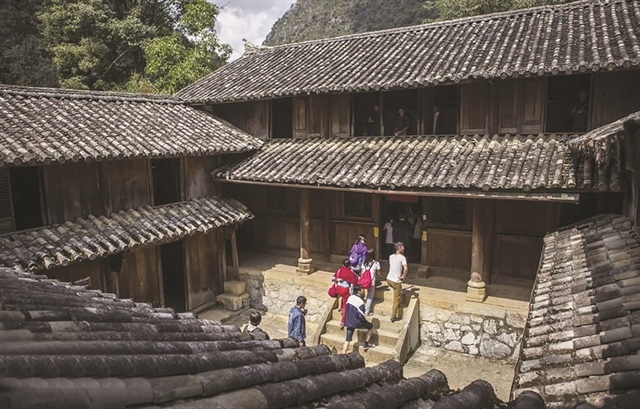 Life & Style
Life & Style


|
| Vương Mansion has been a tourist destination in Hà Giang Province due to its values of architecture, art, history and more. Photo vietnamplus.vn |
HÀ GIANG — Representatives of the Vương family from Đồng Văn District in the northern province of Hà Giang have confirmed they will continue to share the responsibility with the State of preserving and developing the value of the Mông King's Palace (Vương mansion) relic site.
“12 years since it last renovation in 2007, the site is once again in need of repair,” said Vương Duy Bảo, a descendant of the Mông King, at a recent meeting with local authorities.
“Many walls have cracks, the ceilings are damp and the drainage system is blocked,” he said. “The building could collapse at anytime. If we continue to let tourists visit the site, the family will not be held responsible for any injuries.”
Bảo also suggested authorities review regulations at the palace, which has also been recognised as a National Relic Site meaning the State is responsible for preserving it.
He also said agencies should monitor the effectiveness of renovations.
He added that some details tourism information were incorrect in terms of history and architectural value.
Vương Quỳnh Sèo, another descendant of the family, proposed authorities to use the proceeds from ticket sales to renovate the palace.
For the past three months, Sèo and other family members have not received their monthly salaries for managing the site.
Sèo implied that authorities did not seem interested in renovating the site.
Lâm Tiến Mạnh, deputy director of Hà Giang Province’s Culture, Sports and Tourism Department, listened to the proposals and promised to revise the regulations and report to the provincial People’s Committee.
“The Vương family hold the land ownership certificates for the site,” Mạnh said. “We have asked the family to co-ordinate with authorities to preserve the site.”
The Việt Nam National Administration of Tourism website describes the mansion as the residence of Vương Chính Đức (1865-1947), who was regarded as a king who governed the Đồng Văn Plateau region.
The palace has an area of over 1,000sq.m and was built over eight years in the late 19th and early 20th centuries. Most workers were local Mông people and Hui people from Yunnan (China).
In the front of the palace there is a stone gate and surrounding it are two stone walls about 60 centimetres thick and 2.5-3m high.
The palace includes four transversal houses and six lengthwise houses – all with two storeys and a total of 64 rooms. The houses were built in the style of the Qing Dynasty (China). The walls are made of stone with a wooden floor, pillars and columns. The roof is made of tiles and the front of the roof is made with tube tiles decorated with the “longevity” character.
In the main house, a horizontal lacquered board is displayed, decorated with scripts saying “a politically stable border area” (Biên Chính Khả Phong), presented by King Khải Định (1885-1925) to the Vương family in 1913.
Inside the palace, there is a kitchen, cisterns, storerooms, weapons and a stone bathtub.
All the parts, whether made of stone or wood, are carved meticulously with designs of the dragon, phoenix and bat to represent prosperity and longevity of a high-ranking family.
The is a must-see site for tourists visiting Hà Giang Province. — VNS